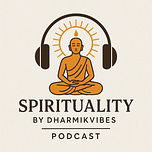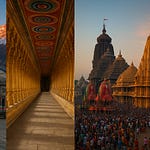The Festival Beyond Diwali
As the glowing lamps of Diwali fade, another beautiful festival rises in their warmth - Bhai Dooj, a celebration of love, protection, and family. It falls on the Dwitiya Tithi (second lunar day) of the bright fortnight in the Hindu month of Kartik, two days after Diwali.
In 2025, Bhai Dooj will be celebrated on Thursday, 23 October.
On this day, sisters pray for their brothers’ well-being and longevity, while brothers vow to protect their sisters throughout life. The ritual may be simple, but its emotional depth and spiritual roots make Bhai Dooj one of India’s most heartfelt festivals.
Historical Background and Mythology
1. The Legend of Yama and Yamuna
According to Hindu mythology, the god of death, Yama, visited his sister Yamuna on the Dwitiya Tithi after a long separation. She welcomed him with flowers, sweets, and a sacred tilak. Deeply moved, Yama declared that any brother who receives a tilak and prayers from his sister on this day will enjoy a long, prosperous life.
From then on, the day came to be known as “Yama Dwitiya”, symbolizing the divine love of siblings.
2. The Story of Krishna and Subhadra
Another version links Bhai Dooj to Lord Krishna’s visit to his sister Subhadra after defeating the demon Narakasura. Subhadra received Krishna with lamps, sweets, and a ceremonial tilak - establishing a tradition that continues in households to this day.
3. Regional Legends and Interpretations
In different parts of India, Bhai Dooj is tied to various local stories. In Maharashtra, it is believed that sisters invite brothers home for a special meal, while in Bengal, the festival is known as Bhai Phonta, where sisters fast until they apply the tilak. In Nepal, the festival of Bhai Tika holds immense importance, with elaborate rituals and garlands of marigold adorning siblings.
Religious and Cultural Significance
Bhai Dooj is more than a day of ritual; it reflects the moral foundation of Indian family life.
1. Symbol of Protection and Blessing
The sister’s tilak signifies her prayers for her brother’s protection, success, and happiness. The brother’s gift symbolizes his promise to stand by his sister in all times.
2. Spiritual Dimension
The act of aarti and tilak represents Shakti (energy) and Ashirwad (blessing). It strengthens familial karma - a moral responsibility towards one’s kin.
3. Socio-Cultural Importance
In an era of changing lifestyles, Bhai Dooj reinforces the Indian ethos of family unity. It reconnects distant members, revives traditions, and brings emotional grounding after the celebratory frenzy of Diwali.
Date and Duration of Bhai Dooj 2025
Festival Date: Thursday, 23 October 2025
Tithi Begins: Dwitiya Tithi on 22 October 2025 (11:58 PM)
Tithi Ends: 23 October 2025 (10:40 PM)
Tilak Muhurta: Between 1:00 PM to 3:30 PM (approximate auspicious window)
The festival lasts a single day, but its preparations often start on the evening following Diwali, when families clean, cook festive meals, and prepare for the sibling reunion.
How Bhai Dooj Reflects India’s Religious Heritage
Bhai Dooj reflects the essence of Indian spirituality and familial devotion through:
Ritual Harmony: Combining devotion (bhakti), duty (dharma), and affection (sneha).
Cultural Diversity: Celebrated as Bhau Beej (Maharashtra, Goa), Bhai Phonta (West Bengal, Assam, Odisha), Bhai Tika (Nepal), Yama Dwitiya (South India).
Inclusivity: The festival transcends biological siblings; even close friends and cousins participate, emphasizing fraternity.
Temples to Visit on Bhai Dooj
Though primarily celebrated at home, several temples hold symbolic significance during Bhai Dooj:
1. Yamuna Temple, Mathura
Believed to be near the banks of the river where Yama met Yamuna. Special prayers for siblings are offered here.
2. Dwarkadhish Temple, Dwarka (Gujarat)
Dedicated to Lord Krishna, this temple sees devotees praying for the divine brother-sister bond between Krishna and Subhadra.
3. Brahma Temple, Pushkar (Rajasthan)
Pilgrims offer lamps and flowers for family unity and long-lasting relationships.
4. Family Puja at Home
Most importantly, the home itself becomes a sacred temple on Bhai Dooj, as the bond between siblings is considered divine.
Bhai Dooj Puja Vidhi - Step-by-Step Ritual Guide
1. Preparation of the Puja Thali
Sisters prepare a thali (plate) with:
A diya (lamp) of ghee or oil
Tilak materials - roli, sandalwood paste, and rice grains
Flowers and sweets
Fruits and a small kalash (pot) with water
2. Welcoming the Brother
The brother visits his sister’s house (or she visits his), where she welcomes him with aarti and a smile.
3. Tilak and Aarti
She applies tilak on his forehead, circles the lamp around him, and recites prayers for his prosperity and protection.
4. Offering Sweets and Gifts
After the aarti, sweets are exchanged. The brother gifts clothes, jewelry, or money, symbolizing love and gratitude.
5. Feast Together
The sister prepares her brother’s favourite meal - often including puris, kheer, halwa, and laddoos. Families share laughter, memories, and photographs.
6. Blessings and Farewell
The ceremony concludes with mutual blessings and heartfelt affection - a reaffirmation of their unbreakable bond.
Regional Variations of Bhai Dooj
North India
Known as Bhai Dooj or Yama Dwitiya. Sisters invite brothers for a traditional meal and apply tilak in the courtyard.
Maharashtra and Goa - Bhau Beej
Sisters perform puja with coconut, betel leaves, and sweets. In some Marathi households, brothers symbolically sit on a wooden stool while sisters perform aarti.
West Bengal and Odisha - Bhai Phonta
Sisters fast until the ceremony is complete. Brothers are worshipped and offered elaborate meals.
Nepal - Bhai Tika
The most elaborate version of the festival, where sisters apply a seven-colored tilak (Saptarangi Tika) and exchange marigold garlands.
What to Do on Bhai Dooj
Clean and decorate your home with lamps and rangoli.
Prepare sweets such as laddoo, barfi, or kheer.
Dress in traditional attire to honour the occasion.
Participate in temple prayers or visit family shrines.
Include younger siblings and cousins in the rituals.
Capture memories through photos and handwritten notes.
Why You Must Celebrate Bhai Dooj
Celebration of Family Values - It teaches gratitude, compassion, and duty toward loved ones.
Cultural Continuity - Helps preserve ancient Indian customs for future generations.
Spiritual Cleansing - Marks the end of the Diwali cycle with love and purity.
Emotional Healing - Strengthens bonds strained by distance or time.
Joyous Tradition - A day filled with laughter, food, gifts, and heartfelt blessings.
Yatra Tip - Experiencing Bhai Dooj in India
If you’re traveling during this period, you can witness authentic celebrations in:
Varanasi - Families performing rituals along the ghats.
Mathura & Vrindavan - Cultural programs and Krishna-Subhadra themed plays.
Mumbai & Pune - Traditional Bhau Beej feasts in Maharashtrian homes.
Kolkata - Sisters celebrating Bhai Phonta with grandeur and sweets.
Kathmandu (Nepal) - The seven-color Tika ceremony and cultural dance events.
The Eternal Bond of Bhai Dooj
Bhai Dooj 2025 is not just a festival; it’s an emotion that ties together love, faith, and family. From the sacred myths of Yama and Yamuna to the heartfelt rituals in every Indian home, it stands as a timeless reminder that relationships built on love and respect are divine.
When sisters light the diya and brothers bow their heads for the tilak, the glow of Bhai Dooj spreads beyond households - illuminating hearts with warmth, trust, and blessings.
So on 23 October 2025, celebrate Bhai Dooj not only as a ritual but as a reaffirmation of life’s most beautiful bond - that of a brother and sister.











